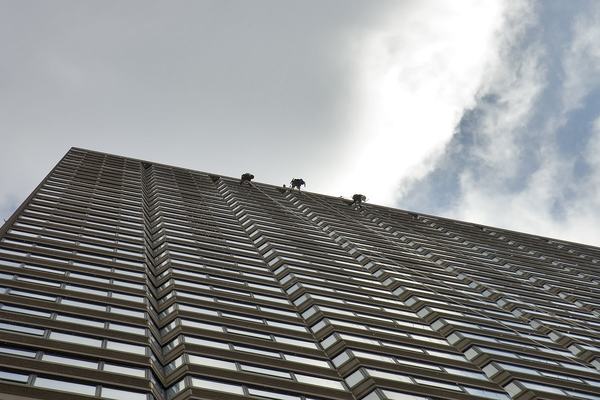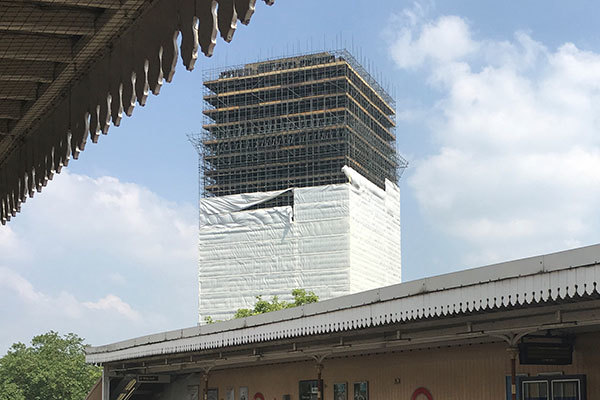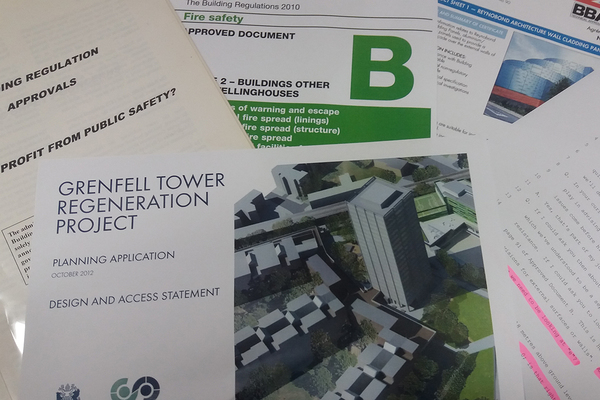You are viewing 1 of your 1 free articles
How politics prevented the chance of stopping Grenfell
The publication of new ‘clarified’ guidance on building regulations shows the scale of the missed opportunity after the Lakanal House fire, explains Peter Apps.
On 28 March five years ago, Eric Pickles was sent a letter. It was from Frances Kirkham, the coroner who had been investigating the deaths of six people in a tower block fire in south London. And it told him to act.
A letter like this should not be taken lightly. The law demands a response within 56 days, setting out the action which will be taken to comply with its demands.
In Mr Pickles’ case, he was told to do several things to prevent a repeat of the Lakanal House fire or a more serious disaster. One of these was to carry out a review of Approved Document B – the official guide to building regulations and fire safety – “with particular regard to the spread of fire over the external envelope of a building”.
This was the chance, many believe, to prevent what happened at Grenfell Tower last June. It slipped away. In Mr Pickles’ response he said research was being carried out, and a new edition of the document would be published in 2016/17. And that was it.
Last week, the government finally published its redraft of the document, which it presents as a mere “clarification” of the existing guidance.
Amid a new typeface and a glossy new design, this clarification also removes what some believe to have been the fatal flaw in the previous (still in force) guidance.
Explaining this requires the use of some technical language.
The previous guidance, at paragraph 12.6, says that “external surfaces of walls should meet the provisions in Diagram 40”.
Diagram 40 (below) defines this for high-rise buildings as “Class 0 (national class) or Class B-s3, d2 or better (European class)”.
The cladding used on Grenfell – aluminium composite material with a polyethylene core – burns like solid petrol. But thanks to weaknesses in the way Class 0 is defined, it was certified by the British Board of Agrément as meeting this standard.
There are mountains of evidence – including a document bearing the signature of the chair of the government’s expert panel, Sir Ken Knight – that the industry believed Class 0 cladding was permitted for use on high rises by this passage in Approved Document B.
"The government was committed to a binary promise to remove twice as much regulation as it introduced"
Since Grenfell, the government has been adamant in saying that this is not true. Cladding, it says, was instead covered by paragraph 12.7, which applies to insulation materials and refers to “filler”. But this ignores the fact that rainscreen cladding panels of the kind used on Grenfell have no insulation function – they keep a building dry.
Nonetheless, despite denying they are a problem, in its ‘clarified’ draft guidance the government has quietly removed paragraph 12.6 and Diagram 40. Instead, it now simply says that all parts of an external wall must meet the higher standard of A2, in line with its forthcoming ban on combustibles.
Had the government reviewed the document when it was told to by the coroner for Lakanal House it may well have taken this step five years earlier – or at very least removed the ambiguity over whether or not paragraph 12.6 applied to cladding. The refurbishment of Grenfell was completed in 2016. There was ample time.
Industry representatives have, in fact, suggested this specific point was raised with the government and ignored.
Why did ministers not act? The answer, it would appear, is politics.
In this period, amid the ‘red tape challenge’ and the pledge to “kill” health and safety culture, the government was committed to a binary promise to remove twice as much regulation as it introduced.
If a civil servant had announced a review of Approved Document B, and said that it should involve a limit on the type of cladding the industry could use, they would have had to assess how much that would cost business.
"The department under Mr Pickles’ leadership was bullish in its approach to deregulation"
Then they would have had to remove other regulations to take out double that cost. No one would have wanted to take this step.
The department under Mr Pickles’ leadership was also bullish in its approach to deregulation. In 2014 responding to a question on why sprinklers had not been made mandatory, then-housing minister Brandon Lewis told parliament: “The Department for Communities and Local Government [responsible for housing] has gone further and removed an even higher proportion of regulations. In that context, members will understand why we want to exhaust all non-regulatory options before we introduce new regulations.”
Fire safety campaigners and professionals recall that in meetings with DCLG in this period, they were told that as fire deaths were coming down statistically there was no need for new regulation. But this allowed warnings to go unheeded.
That the changes published last week are being made after the disaster experts so frequently warned of only compounds the tragedy of Grenfell.
And as for Mr Pickles? A day after Dame Judith Hackitt’s report described the system of building regulation – which he was responsible for from 2010 to 2015 – as broken, Theresa May awarded him a peerage for his efforts.
Pete Apps, news editor, Inside Housing
The Paper Trail: The Failure of Building Regulations
Read our in-depth investigation into how building regulations have changed over time and how this may have contributed to the Grenfell Tower fire:
Never Again campaign
In the days following the Grenfell Tower fire on 14 June 2017, Inside Housing launched the Never Again campaign to call for immediate action to implement the learning from the Lakanal House fire, and a commitment to act – without delay – on learning from the Grenfell Tower tragedy as it becomes available.
One year on, we have extended the campaign asks in the light of information that has emerged since.
Here are our updated asks:
GOVERNMENT
- Act on the recommendations from Dame Judith Hackitt’s review of building regulations to tower blocks of 18m and higher. Commit to producing a timetable for implementation by autumn 2018, setting out how recommendations that don’t require legislative change can be taken forward without delay
- Follow through on commitments to fully ban combustible materials on high-rise buildings
- Unequivocally ban desktop studies
- Review recommendations and advice given to ministers after the Lakanal House fire and implement necessary changes
- Publish details of all tower blocks with dangerous cladding, insulation and/or external panels and commit to a timeline for remedial works. Provide necessary guidance to landlords to ensure that removal work can begin on all affected private and social residential blocks by the end of 2018. Complete quarterly follow-up checks to ensure that remedial work is completed to the required standard. Checks should not cease until all work is completed.
- Stand by the prime minister’s commitment to fully fund the removal of dangerous cladding
- Fund the retrofitting of sprinkler systems in all tower blocks across the UK (except where there are specific structural reasons not to do so)
- Explore options for requiring remedial works on affected private sector residential tower blocks
LOCAL GOVERNMENT
- Take immediate action to identify privately owned residential tower blocks so that cladding and external panels can be checked
LANDLORDS
- Publish details of the combinations of insulations and cladding materials for all high rise blocks
- Commit to ensuring that removal work begins on all blocks with dangerous materials by the end of 2018 upon receipt of guidance from government
- Publish current fire risk assessments for all high rise blocks (the Information Commissioner has required councils to publish and recommended that housing associations should do the same). Work with peers to share learning from assessments and improve and clarify the risk assessment model.
- Commit to renewing assessments annually and after major repair or cladding work is carried out. Ensure assessments consider the external features of blocks. Always use an appropriate, qualified expert to conduct assessments.
- Review and update evacuation policies and ‘stay put’ advice in the light of risk assessments, and communicate clearly to residents
- Adopt Dame Judith Hackitt’s recommended approach for listening to and addressing tenants’ concerns, with immediate effect
CURRENT SIGNATORIES:
- Chartered Institute of Housing
- G15
- National Federation of ALMOs
- National Housing Federation
- Placeshapers













